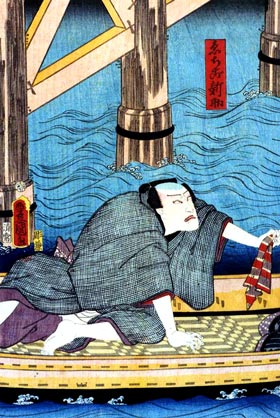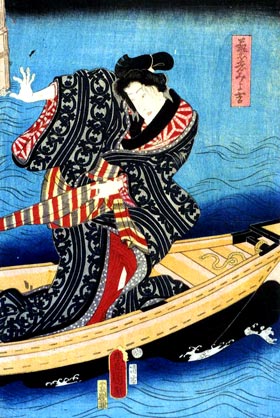| CHIJIMIYA SHINSUKE |
| Play title | Hachiman Matsuri Yomiya no Nigiwai |
| Author | Kawatake Shinshichi II |
| History |
The drama "Hachiman Matsuri Yomiya no Nigiwai" was premiered at the Ichimuraza in the 7th lunar month of 1860 [casting]. It was based on two true incidents, the 1807 collapse of the Eitai Bridge during the Hachiman Shrine festival in Fukagawa and the 18th of the 3rd lunar month of 1821 murder-suicide of a Fukagawa geisha, Omino, and an Edo merchant named Yoshida Jinbei. This play has been replaced by two other works which it influenced: "Kagotsurube Sato no Eizame" (1888), by Kawatake Mokuami's disciple Kawatake Shinshichi III, and "Meigetsu Hachiman Matsuri" (1918) by Daigo Ikeda. It is sometimes revived but far less frequently than the two others. |
| Structure |
The original drama was made up of 4 acts. The current version of "Chijimiya Shinsuke" is made up of 3 acts and 6 scene, lasting around 2 hours. |
| Key words |
Chijimi Eitaibashi Eitaibashi Rakkyô Jiken Enkirimono Fukagawa Hachiman Matsuri Koroshiba Miuke Sewamono Sumidagawa Tekomai |
| Summary |
The play opens on the eve of the Hachiman festival in Fukagawa as the geisha Miyokichi arrives at the teahouse Obanaya. When her guest for the evening, Genzaemon, and his friends begin taunting a merchant, Shinsuke, who has come from Niigata to sell chijimi cloth for summer kimono, Miyokichi makes them stop. Miyokichi in fact has a longtime lover, Shinzaburô, a samurai who lost his position when a precious incense burner he had charge of was stolen. He must find it again to recover his status. Miyokichi has the character "shin" tatooed on her upper arm, in token of their love. Genzaemon persists in asking about it, and Otsuyu, the teahouse proprietor, persuades Shinsuke to tell Genzaemon that "shin" stands for Shinsuke and that he is the man Miyokichi loves. The next day the Eitai Bridge collapses from the weight of people crossing it to reach the festival. Miyokichi is among the crowd on the bridge and is thrown into the Sumida River, but is saved by Shinsuke, who is passing by in a boat. Taking advantage of the situation, the besotted Shinsuke asks her to become his wife even though he knows that Shinzaburô is her lover. Miyokichi, grateful to Shinsuke for rescuing her, promises she will marry him if Shinzaburô ever regains his position as a samurai. In due course Shinzaburô does recover the missing incense burner, and decides to part with Miyokichi, go back to his life as a samurai and marry his fiancee. As an excuse he tells Miyokichi he has heard rumors of her friendship with Shinsuke. She is still in shock when Shinsuke arrives with 50 gold pieces, money he has raised by pawning his merchandise, to redeem her contract, and tells him that she no longer wants to see him. Having lost both his merchandise and Miyokichi, Shinsuke uses the money to buy a sword and starts killing people at random. When he kills Miyokichi, he regains his senses, and only then, finding a letter on her person, does he discover that she is his own sister, whom he has been trying to find for many years. Source: Sasaguchi Rei |
| Trivia |
Miyokichi is dressed up as a tekomai in the opening scene of "Chijimiya Shinsuke". This is the traditional costum of the Fukagawa geisha during the Hachiman festival. |
 |
 |
|
The actors Ichikawa Kodanji IV and Iwai Kumesaburô III playing the roles of Shinsuke and Miyokichi in the drama "Hachiman Matsuri Yomiya no Nigiwai", which was staged in the 7th lunar month of 1860 at the Ichimuraza (print made by Utagawa Toyokuni III) |
|
|
|
| Contact | Main | Top | Updates | Actors | Plays | Playwrights | Programs | Links | FAQ | Glossary | Chronology | Illustrations | Prints | Characters | Derivatives | Theaters | Coming soon | News |